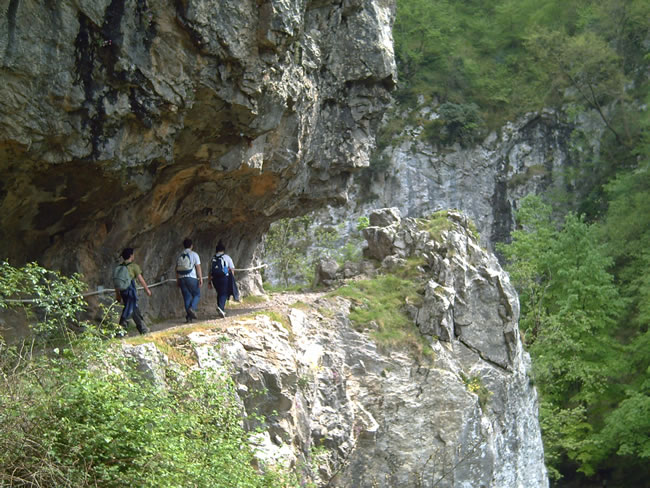|
Church Of Santo Adriano De TuÃąÃģn
The Church of Santo Adriano de TuÃąÃģn ( es, Iglesia de Santo Adriano de TuÃąÃģn) is a Roman Catholic Pre-Romanesque church in the village of TuÃąÃģn, Asturias, Spain dedicated to Saint Adrian. The church is located on the bank of the River Trubia, next to an old Roman road. Founded on January 24, 891, by Alfonso III of Asturias and his wife Jimena of Navarra as a monastery church, it went through large transformations at the beginnings of the 12th century. It was declared a Spanish national monument in June 1931. Architecture The church stands on a classic basilica ground plan, although in the 17th and 18th centuries it was extended with a nave structure at the western end, and a bell gable. Decoration Mural paintings were rediscovered in the 20th century. The fresco paintings in this church are the only remains of Mozarabic painters' work in an Asturian art workshop. See also *Asturian art *Catholic Church in Spain , native_name_lang = , image = S ... [...More Info...] [...Related Items...] OR: [Wikipedia] [Google] [Baidu] |
Santo Adriano
Santo Adriano ( Asturian: Santu Adrianu) is a municipality in the Autonomous Community of the Principality of Asturias. It is bordered on the north by Oviedo, on the east by Ribera de Arriba and MorcÃn, on the south by QuirÃģs and Proaza and on the west by Proaza and Grado. Geography It is one of the smaller municipalities in Asturias in both area and population. Like the majority of the rural areas in Asturias, the population is receding. The highest point in the municipality is Grandamiana, at 813 m. Afterwards are Los Navalones at 756 and El PiantÃģn at 750. Fifty-eight percent of the municipal area is between 400 and 800 meters high. Nearly a quarter of the area has a slope of more than 50%. The lowest point is along the Trubia River, at 140 meters. In addition to the Trubia, which crosses the territory from south to north, there are many small arroyos which flow into it, such as the PicarÃģs, the RebregÃĄu, the Tresarcu and the Xanas. The latter flows alon ... [...More Info...] [...Related Items...] OR: [Wikipedia] [Google] [Baidu] |
Alfonso III Of Asturias
Alfonso III (20 December 910), called the Great ( es, el Magno), was the king of LeÃģn, Galicia and Asturias from 866 until his death. He was the son and successor of OrdoÃąo I. In later sources he is the earliest to be called "Emperor of Spain." He was also titled "Prince of all Galicia" (''Princeps totius Galletiae''). Life Alfonso's reign was notable for his comparative success in consolidating the kingdom during the weakness of the Umayyad princes of CÃģrdoba. He fought against and gained numerous victories over the Muslims of al-Andalus. During the first year of his reign, he had to contend with a usurper, Count Fruela of Galicia. He was forced to flee to Castile, but after a few months Fruela was assassinated and Alfonso returned to Oviedo. He defeated a Basque rebellion in 867 and, much later, a Galician one as well. He conquered Porto and Coimbra in 868 and 878 respectively. In about 869, he formed an alliance with the Kingdom of Pamplona, and solidified this link ... [...More Info...] [...Related Items...] OR: [Wikipedia] [Google] [Baidu] |
Churches In Asturias With Pre-Romanesque Work
Church may refer to: Religion * Church (building), a building for Christian religious activities * Church (congregation), a local congregation of a Christian denomination * Church service, a formalized period of Christian communal worship * Christian denomination, a Christian organization with distinct doctrine and practice * Christian Church, either the collective body of all Christian believers, or early Christianity Places United Kingdom * Church (Liverpool ward), a Liverpool City Council ward * Church (Reading ward), a Reading Borough Council ward * Church (Sefton ward), a Metropolitan Borough of Sefton ward * Church, Lancashire, England United States * Church, Iowa, an unincorporated community * Church Lake, a lake in Minnesota Arts, entertainment, and media * ''Church magazine'', a pastoral theology magazine published by the National Pastoral Life Center Fictional entities * Church (''Red vs. Blue''), a fictional character in the video web series ''Red vs. Blue'' * Churc ... [...More Info...] [...Related Items...] OR: [Wikipedia] [Google] [Baidu] |
9th-century Churches In Spain
The 9th century was a period from 801 ( DCCCI) through 900 ( CM) in accordance with the Julian calendar. The Carolingian Renaissance and the Viking raids occurred within this period. In the Middle East, the House of Wisdom was founded in Abbasid Baghdad, attracting many scholars to the city. The field of algebra was founded by the Muslim polymath al-Khwarizmi. The most famous Islamic Scholar Ahmad ibn Hanbal was tortured and imprisoned by Abbasid official Ahmad ibn Abi Du'ad during the reign of Abbasid caliph al-Mu'tasim and caliph al-Wathiq. In Southeast Asia, the height of the Mataram Kingdom happened in this century, while Burma would see the establishment of the major kingdom of Pagan. Tang China started the century with the effective rule under Emperor Xianzong and ended the century with the Huang Chao rebellions. While the Maya experienced widespread political collapse in the central Maya region, resulting in internecine warfare, the abandonment of cities, and a northward ... [...More Info...] [...Related Items...] OR: [Wikipedia] [Google] [Baidu] |

